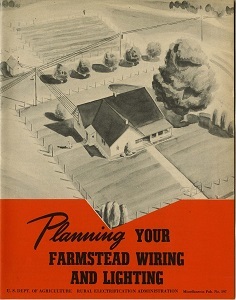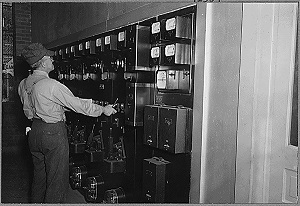

Electrifying Rural America
During the Great Depression, communities banded together to bring electricity to America's farmland
"Broadband: Connecting the Last Mile in Rural America," Panel Discussion at "Investing in Rural America" Conference, October 2, 2019.
"An Estimated Structural Model of Entrepreneurial Behavior," Working Paper No. 17-07, May 2017
In May 1935, President Franklin Roosevelt issued an executive order creating the Rural Electrification Administration (REA) "to initiate, formulate, administer, and supervise a program of approved projects with respect to the generation, transmission, and distribution of electric energy in rural areas." The REA was part of the suite of public works projects under the New Deal designed to counteract the Great Depression. Congress set aside $100 million ($1.88 billion in 2020 dollars) for the new agency, enabling it to make loans to finance the construction of electricity generation and transmission to rural areas.
Initial meetings between REA leaders and private utilities seemed promising. But when the utilities submitted their proposal to the government, it exceeded the $100 million budget and fell short of the government's goal of widespread coverage. The utilities also maintained that without assistance to help finance the wiring of rural homes and the purchase of electric appliances, farmers would not have enough demand for electricity to make the service sustainable.
Congress would ultimately take that suggestion to heart; in 1936, the Rural Electrification Act formally established the REA as a government agency and authorized it to also make loans to wire homes and to outfit them with lights and appliances. But by then, private utilities had become increasingly reluctant to work with the REA.
"There was some unfavorable language in the loan offers to the private utilities that placed restrictions on what they could do if they took the money, and they couldn't work those details out," says Carl Kitchens, an economic historian at Florida State University who has studied rural electrification.
With private utilities reluctant to get involved, the REA turned to another vehicle that was quite familiar to farmers: the cooperative, commonly referred to as a co-op.
"When you read books from that era, one of the things people always talk about is how rural communities can solve different problems by forming a co-op," says Price Fishback, an economic historian at the University of Arizona whose research focuses on New Deal programs. "Every county had several co-ops of varying sizes."
A co-op is an organization that is collectively owned by its members, making them both customers and shareholders. Co-ops had a long history in agriculture. Farmers had banded together to share resources and improve their bargaining power for inputs like seed, fertilizer, and equipment. But there were few examples of co-ops designed to distribute electricity — only 33 electric co-ops existed in the United States in 1930.
Once the REA decided to work with co-ops to accomplish its goals, it set about helping farmers organize. Many states did not have laws in place to govern electric co-ops. So, in 1937, the REA drafted a model Electric Cooperative Corporation Act that states could use as a template for laws authorizing electric co-ops and establishing rules for their governance. The model stated that co-ops were to be nonprofits and governed by member-elected boards, with each member having one vote.
Despite pent-up demand for electricity, acquiring members initially proved a challenge for many co-ops. Farmers were worried that taking loans from the government would put their farms at risk if they defaulted. REA representatives assured them that the electrical equipment itself would serve as collateral for the loans. Membership fees were another sticking point. Co-op members were required to pay $5 to join, a substantial sum in the midst of the Great Depression (equivalent to almost $100 in 2020).
North Carolina farmers were early adopters of the electric co-op model. Farmers in the state had actually been exploring electrification through co-ops before the creation of the REA but were unable to secure the finances they needed to undertake the project. In 1936, residents of Edgecombe and Martin counties formed the first electric co-op in the state, the Edgecombe-Martin County Electric Membership Corp., initially serving 82 members.
The Lights Come On
Once co-ops organized and drafted a proposal, they could borrow at low interest from the REA (between 2 percent and 3 percent) to finance construction of transmission lines and to pay for wiring and appliances for farms and homes. Edgecombe-Martin, for example, received a loan of $32,000 (nearly $600,000 in 2020 dollars) at 2 percent interest. In addition to extending the funding, the REA also helped co-ops find ways to reduce costs.
"The REA hired engineers to help design new ways to build the lines," says Kitchens. Rural electric customers required a different type of load than urban customers, allowing engineers to use single-phase wires and space utility poles farther apart. The REA was also able to make bulk purchases for materials and standardize construction practices to further reduce the per-mile costs.
These techniques allowed the REA to reduce the cost of laying rural power lines to an average of less than $825 per mile by the end of the 1930s — a significant drop from the roughly $2,000 per mile utilities had previously estimated.
Another key feature of the REA program was the extension of credit to wire rural homes and fund purchases of electrical appliances. This ensured a demand for electricity from the start, which allowed the co-ops to take advantage of economies of scale and keep usage costs low. Indeed, a 2020 article in the Journal of Economic Perspectives by Kenneth Lee of the Energy Policy Institute at the University of Chicago in India and Edward Miguel and Catherine Wolfram of the University of California, Berkeley, found that this was crucial to the success of rural electrification in the United States compared to electrification efforts in other countries that did not provide such support.
Receive an email notification when Econ Focus is posted online.
By submitting this form you agree to the Bank's Terms & Conditions and Privacy Notice.




